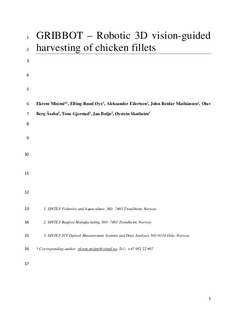| dc.contributor.author | Misimi, Ekrem | |
| dc.contributor.author | Øye, Elling Ruud | |
| dc.contributor.author | Eilertsen, Aleksander | |
| dc.contributor.author | Mathiassen, John Reidar Bartle | |
| dc.contributor.author | Åsebø Berg, Olav | |
| dc.contributor.author | Gjerstad, Tone Beate | |
| dc.contributor.author | Buljo, Jan Olaf | |
| dc.contributor.author | Skotheim, Øystein | |
| dc.date.accessioned | 2017-12-05T10:06:33Z | |
| dc.date.available | 2017-12-05T10:06:33Z | |
| dc.date.created | 2016-01-28T11:15:49Z | |
| dc.date.issued | 2016 | |
| dc.identifier.citation | Computers and Electronics in Agriculture. 2016, 121 84-100. | nb_NO |
| dc.identifier.issn | 0168-1699 | |
| dc.identifier.uri | http://hdl.handle.net/11250/2469222 | |
| dc.description.abstract | In Norway, the final stage of front half chicken harvesting is still a manual operation due to a lack of automated systems that are suitably flexible with regard to production efficiency and raw material utilisation. This paper presents the ‘GRIBBOT’ – a novel 3D vision-guided robotic concept for front half chicken harvesting. It functions using a compliant multifunctional gripper tool that grasps and holds the fillet, scrapes the carcass, and releases the fillet using a downward pulling motion. The gripper has two main components; a beak and a supporting plate. The beak scrapes the fillet down the rib cage of the carcass following a path determined by the anatomical boundary between the meat and the bone of the rib cage. The supporting plate is actuated pneumatically in order to hold the fillet. A computer vision algorithm was developed to process images from an RGB-D camera (Kinect v2) and locate the grasping point in 3D as the initial contact point of the gripper with the chicken carcass for harvesting operation. Calibration of camera and robot was performed so that the grasping point was defined using 3D coordinates within the robot’s base coordinate frame and tool centre point. A feed-forward Look-and-Move control algorithm was used to control the robot arm and generate the motion trajectories, based on the 3D coordinates of the grasping point as calculated from the computer vision algorithm. The results of an experimental proof-of-concept demonstration showed that GRIBBOT was successful both in scraping the carcass, grasping chicken fillets automatically and in completing the front half fillet harvesting process. It demonstrated a potential for the flexible robotic automation of the chicken fillet harvesting operation. Its commercial application, with further development, can result in automated fillet harvesting, while future research may also lead to optimal raw material utilisation. GRIBBOT shows that there is potential to automate even the most challenging processing operations currently carried out manually by human operators. | nb_NO |
| dc.language.iso | eng | nb_NO |
| dc.title | GRIBBOT - Robotic 3D vision-guided harvesting of chicken fillets | nb_NO |
| dc.type | Journal article | nb_NO |
| dc.type | Peer reviewed | nb_NO |
| dc.description.version | acceptedVersion | nb_NO |
| dc.source.pagenumber | 84-100 | nb_NO |
| dc.source.volume | 121 | nb_NO |
| dc.source.journal | Computers and Electronics in Agriculture | nb_NO |
| dc.identifier.doi | 10.1016/j.compag.2015.11.021 | |
| dc.identifier.cristin | 1324894 | |
| dc.relation.project | Norges forskningsråd: 225349 | nb_NO |
| cristin.unitcode | 7566,5,0,0 | |
| cristin.unitcode | 7401,90,41,0 | |
| cristin.unitname | Prosessteknologi | |
| cristin.unitname | Optiske målesystemer og dataanalyse | |
| cristin.ispublished | true | |
| cristin.fulltext | postprint | |
| cristin.qualitycode | 2 | |
